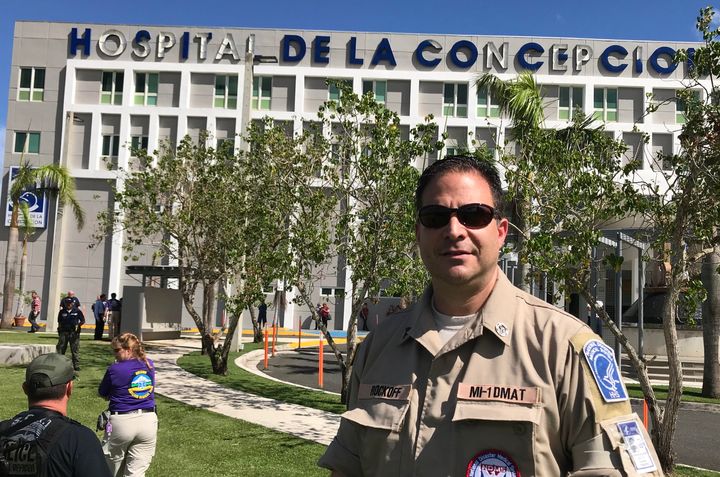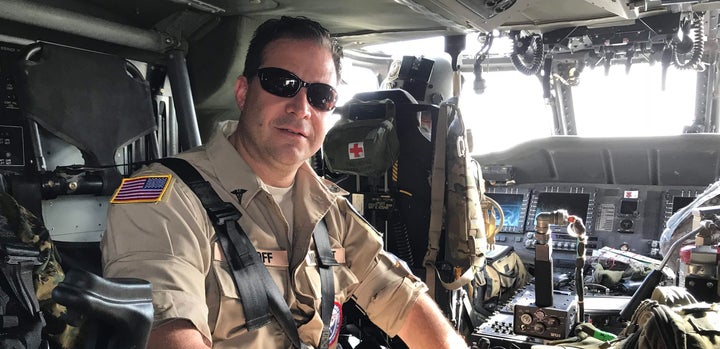
DETROIT ― Emergency room physician Steven Rockoff has spent the last month in one of the nation’s most intense COVID-19 hot spots, trying desperately to figure out the disease even as he scrambles to manage supplies, people and patients.
“We don’t even know the treatments yet,” Rockoff says, “and it’s scary because we’re seeing healthy people taken out by this virus.”
This is not his first encounter with a large-scale medical crisis. Rockoff, 49, is also part of Michigan’s Disaster Medical Assistance Team, a squad of frontline workers that the federal government dispatches to emergency situations around the country.
In 2017, Rockoff was part of a mission to help staff a hospital in Puerto Rico following Hurricane Maria. During that two-week stint, Rockoff learned some valuable lessons about how to handle mass casualties and make the best of a difficult medical situation.
Rockoff, who is chief of Henry Ford West Bloomfield Hospital’s emergency department, says he never imagined he’d be applying those lessons in one of Detroit’s more upscale suburbs. Although there are obvious differences between Michigan’s coronavirus outbreak and Puerto Rico’s health crisis after Maria, there are plenty of similarities, too.
The Mission To Puerto Rico
Helping people in crisis moments is a calling for Rockoff. As a teenager growing up in western Pennsylvania, he says, he would stop for roadside accidents, to offer comfort and whatever aid he could until emergency crews arrived. After college, Rockoff worked for several years as a paramedic before going back to medical school.
Emergency medicine felt like a natural fit, and, even today, he works with a Life Flight team that transports trauma patients across the state. That impulse led him to join Michigan’s disaster team, which is what put him on a charter flight to San Juan with more than 200 fellow health care workers from around the country.
Upon arrival, they broke up into teams and scattered across the island. Rockoff’s destination was a hospital in San Germán, in the island’s southwest corner, where the storm had severed transportation and communication lines and taken down the cellphone towers. Eight military Black Hawk helicopters ferried Rockoff and his colleagues to the site and, with no way to warn hospital staff they were coming, they effectively announced their arrival when the aircraft set down noisily on the lawn.

The hospital structure was relatively new, and because it had a generator, it still had power. But that was about the only thing working right, Rockoff recalls. Workers, pharmaceuticals, equipment ― all were in short supply. The only thing that the hospital had in surplus was patients, who were coming from all over that part of the island.
Some had injuries, frequently from efforts to clear debris or make home repairs. But mostly, he says, it was people whose chronic conditions had turned into emergencies because of the strain or an inability to get routine care and medication. Diabetes complications were especially common.
Rockoff and his colleagues had to improvise treatments. When a drug to slow a racing heart wasn’t available, Rockoff says, he used a treatment in which the patient blew into the the tube of a pen. While hardly perfect, it worked well enough.
At one point, Rockoff says, he and his staff thought they would have to decide whether to use the hospital’s last available ventilator on an elderly man who was in severe distress and had little chance of survival. Somebody finally found an extra ventilator, sparing Rockoff and his colleagues the painful choice. And that elderly patient with the bleak odds went on to survive.
The Disaster In Detroit
Ventilator shortages in Detroit have been a major fear ever since the novel coronavirus gained a foothold in the U.S. and the first cases appeared in Michigan. Even before the surge of patients hit, hospitals began discussing how they might have to make the very sorts of rationing decisions that confronted Rockoff’s DMAT team in Puerto Rico.
The public got a glimpse of this thinking in late March, when an internal document about triage decisions from Henry Ford was leaked to the press. It was, administrators said later, a draft document designed to explain how the system would ration ventilators in a “worst-case scenario” ― one, they emphasized, that hadn’t happened yet.
A month later, it still hasn’t happened. The supply of available ventilators got down to a handful at a few junctures, according to Rockoff, but the system always had others available ― which is a credit, he says, to the Henry Ford supply managers who made sure to acquire equipment while it was still possible to buy it.
“We’ve changed our treatment algorithms probably four or five times already.”
- Steven Rockoff, emergency room physician
Personal protective gear, especially the N95 masks that offer more reliable protection against COVID-19 transmission, was also a worry. The hospital came close to running out of gowns on several occasions, he says, and switched N95 protocol to follow guidelines, from the U.S. Centers for Disease Control and Prevention, allowing for greater reliance on traditional surgical masks in some situations.
Rockoff has faith in the CDC guidance, he says, but he has heard enough stories from elsewhere in Detroit, as well as from New York and other parts of the country, to know that health care workers in those places don’t always have what they need ― and that, following exposure to the virus, some are getting sick.
“It’s unthinkable and unconscionable, to be honest, that our frontline providers don’t have the means to care for our citizens with proper equipment,” he says.
A Little Innovation, A Little Improvisation
Dealing with a brand-new pathogen creates its own challenges, since, as Rockoff puts it, “there’s no playbook yet.” The system’s infectious disease experts keep close track of patient progress, and then, after comparing with studies and what they’re hearing from counterparts at other hospitals, they sometimes change guidelines for how to approach COVID-19.
Among the shifts, Rockoff says, are new efforts to treat patients early with steroids and place them “prone” ― that is, on their bellies ― because that allows them to get more air in their lungs. So far, he says, it’s helping to keep people off ventilators, which is good for them and leaves more machines for those who still need them.
“We’ve changed our treatment algorithms probably four or five times already,” Rockoff says. “When we find something that is better, they will update it and they’ll put it out to the frontline teams and we will do it.”
Like other health care workers in southeast Michigan, Rockoff feels like the surge of patients may be starting to subside. And he says the state’s stay-at-home order deserves a lot of the credit because, without it, “our health system would have collapsed.”
“We barely made it with the stay-at-home order, and I mean barely,” he adds, noting that the hospital had to increase its intensive care unit capacity by more than 50% to accommodate all the COVID-19 patients. Even then, according to Rockoff, the hospital had to transfer patients because it had no more room.
The stay-at-home order has become the subject of political controversy lately, with some business and Republican leaders pushing to loosen it as quickly as possible. Michigan Gov. Gretchen Whitmer (D) has said she is consulting with them, along with fellow governors and public health experts, about when and how to dial back the restrictions.
Whatever the decision, Rockoff says he is already preparing for the possibility of a resurgence. He fears that people will ease up on social distancing and other practices that are slowing the pandemic’s spread, even though the virus will still be in circulation.
That is one way the pandemic is different from the storm that ravaged Puerto Rico. “A hurricane, you know, it comes through, it does its damage, and then it’s gone ― one and done,” Rockoff says. “This may simmer now for months.”
- Stay up to date with our live blog as we cover the COVID-19 pandemic
- What happens if we end social distancing too soon?
- What you need to know about face masks right now
- How long are asymptomatic carriers contagious?
- Lost your job due to coronavirus? Here’s what you need to know.
- Everything you need to know about coronavirus and grief
- The HuffPost guide to working from home
- What coronavirus questions are on your mind right now? We want to help you find answers.
- Everyone deserves accurate information about COVID-19. Support journalism without a paywall — and keep it free for everyone — by becoming a HuffPost member today.
